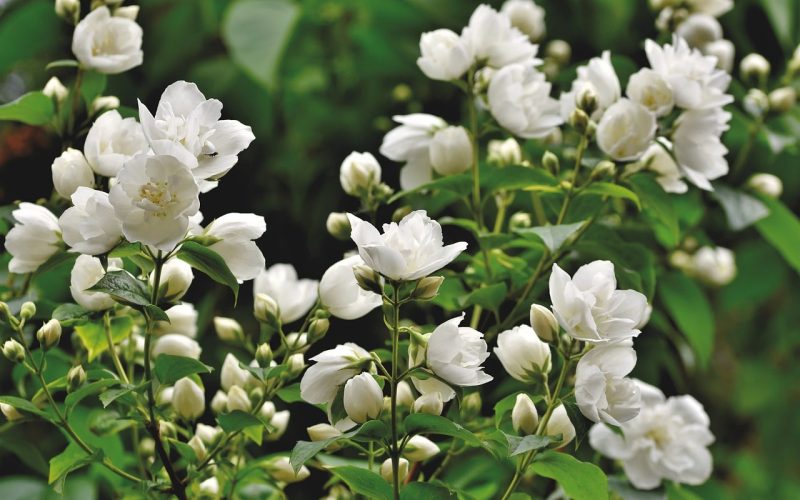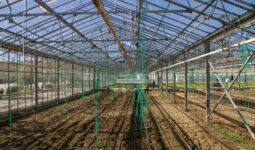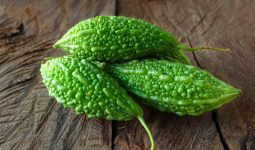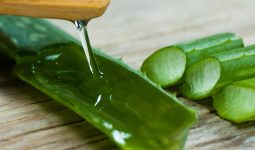Texas is known as the Lone Star State, but did you know it’s also home to many different types of shrubs? There are so many to choose from that it may feel like you’re at an all-you-can-eat buffet!
But with an almost unlimited number of choices, how do you know what shrub to pick and what not to choose?
The answers lie in knowing which different types of shrubs in Texas can thrive in a particular soil. Not only that, but also knowing how much care each type requires.
Now, talking about shrubs, they are well known for their ability to create privacy borders and add color to your landscape.
The great news is that there are many different types of shrubs in Texas, meaning you can avoid the hassle of importing them from other places around the country or globe!
Here are native Texas shrubs that will grow well in your yard, adding beauty and charm wherever you decide to plant them.
1. Chili Pequin
There are different types of shrubs in Texas, and here’s the first we’ll discuss. Native to Texas, as its name implies, chile pequin peppers are actually small berries from a short (3-to-6-foot) plant.
Greenish yellow in color when immature, they turn red when fully ripe. The fruit has a spicy bite and is generally pickled whole and used as an ingredient in condiments.
They are only available once seasonally at farmers’ markets or specialty grocers like Central Market. You can now find it at major supermarkets such as H-E-B throughout most of the year.
It also makes a great container plant if you grow it in the sand rather than potting soil, so it doesn’t become rootbound.
2. Autumn Sage
If you’re looking for an eye-catching shrub that requires little maintenance, checking the list of the different types of shrubs in Texas, autumn sage is perfect.
It has purple flowers in spring and summer and turns a lovely shade of burgundy in fall. The leaves are thick, coarse, and gray-green.
Plus, this is an excellent plant for erosion control and gives off a pleasant scent when walked by or brushed against. It also grows well in poor soil with little water—making it an ideal plant for yards in arid climates.
3. Texas Mountain Laurel
This herbaceous perennial has clusters of yellow flowers in spring, along with reddish fall foliage. It grows about 4 feet tall and is adaptable to varying sun and water levels.
This is definitely one of the most adorable plants on the list of the different types of shrubs in Texas!
4. Texas Sage
Texas sage is a drought-tolerant perennial shrub with an upright, rounded form. It has green leaves that turn yellow in fall and red-orange tubular flowers in late summer. Texas sage will grow 6–10 feet tall and wide, so ensure there’s plenty of space.
Moreso, Texas sage looks especially pretty as a backdrop for other plants or as a border on either side of a walkway.
Flowers are attractive to bees but do not attract hummingbirds like our native wildflower honeysuckle (Lonicera sempervirens).
Like most desert plants, Texas sage does not need much water or fertilizer once established. It is also very low maintenance—the flowers are unscented, so they don’t attract annoying insects!
With these, compared to other different types of shrubs in texas, what more can you ask for?
5. Viburnums
Next on our list of the different types of shrubs in Texas is the Viburnums. These evergreens are prized for their foliage that turns a stunning red or orange during fall months.
The texture and size of a viburnum also make it one of our favorite hedges in Houston. They grow at least 6 feet high with a relatively wide base.
6. Texas Lantana
The coxcomb or Lantana is an herbaceous perennial and has become widespread and naturalized along roadsides. The bright orange flowers are typically 2 inches (5.1 cm) in diameter.
They have a five-lobed corolla with two upper lobes larger than three lower lobes. In some cases, all of these flower parts are more than 1 inch (2.54 cm) long. One of the most beautiful of the different types of shrubs in Texas.
7. Esperanza
The esperanza is a perennial with attractive, fragrant yellow flowers bloom in spring. This plant can get up to 10 feet tall and 8 feet wide, but it will be smaller if grown in containers or regularly pruned.
The name esperanza means hope in Spanish, and owners say it describes their feelings for these plants perfectly. Esperanzas attract birds, butterflies, and hummingbirds with their sweet-smelling blooms.
As a result, this makes them excellent choices for attracting wildlife into gardens. They are hardy from zones 7 to 11 and can handle lots of shade and full sun.
8. Rock Rose
Next to be discussed on the different types of shrubs in Texas is the Rock Rose. Also known as creosote bush, it is a genus of herbaceous perennials.
The generic name Pavonia refers to one species in which plants are covered with glandular hairs resembling moss.
But in reality, there are no mosses found among its relatives. Lasiopetala derives from the Greek lasios (hairy) and petalon (petal), describing their leaf structure. The genus is distributed over a broad area, covering all continents except Antarctica.
9. Prickly Pear
Prickly Pear cactus is a type of plant included in the list of the different types of shrubs in Texas. It is green in color and has small red flowers. The cactus is spiny, and it grows slowly.
Moreso, it prefers dry areas with full sun but can tolerate various soil types. Prickly Pear also makes great houseplants as long as you provide them with plenty of sunlight, keep them well watered, and do not overwater them. For these plants to thrive, they should be fed once every two weeks.
Use an all-purpose granular fertilizer that contains both nitrogen and phosphorus. To give it a well-rounded diet, use timed-release fertilizer twice a year.
10. White Mistflower
Ageratina havanensis, also called White Mistflower, is a perennial like other different types of shrubs in Texas. It grows in USDA hardiness zones 8-10. It has long, thin, white flowers and can grow up to 5 feet tall.
Also, with low maintenance and deer-resistant qualities, A. havanensis is a popular shrub for gardens in central and south Texas. Be sure not to confuse it with Whitetop (Ageratina altissima), which looks similar but grows taller.
You can identify them by their habitat: Whitetops will be found on hillsides, and White Mistflower prefers clay soil on prairies or rocky outcrops.
11. Flame Acanthus
Anisacanthus quadrifidus is a species of flowering plant in the family Apocynaceae. It has been naturalized as a common roadside and garden escape in many areas.
Its common names include four-leaved tearthumb and flame acanthus, derived from its striking red fruit.
This bushy herbaceous perennial reaches 2–3 m tall, with palmately lobed leaves 4–12 cm long and 3–6 cm broad.
The flower heads are 2–4 cm in diameter, with scarlet red flowers followed by vivid red fruits 6–8 mm in diameter. Read further to get to know other different types of shrubs in Texas!
12. Buttonbush
Buttonbush is a tall, fast-growing tree that can easily grow in full sun. It also grows best when planted in moist, well-drained soil. Buttonbush is an early bloomer, with beautiful white flowers appearing during March and April.
Also, the plant produces a small fruit in late summer that is black when ripe but very bitter. Buttonbush can tolerate poor soil conditions and survives relatively harsh weather patterns.
13. American Beautyberry
We aren’t leaving this beauty, as the name implies, out of the list of different types of shrubs in Texas. American beautyberry is a beautiful, native deciduous shrub known for its purple berries.
The American Beautyberry will grow in the sun or part shade and in various soil types. Growing up to 15 feet tall and equally wide, it can be used as a single accent plant or in mass.
14. Yaupon Holly
This hardy holly tree is one of only a few hollies that are native to North America. It was used by Native Americans for medicinal and ceremonial purposes as early as 7,000 years ago. In the fall, Ilex vomitoria turn a brilliant red color.
However, you’ll want to showcase its lush green summertime look in your landscaping. With its deep-green leaves and dense habit, Yaupon Holly is a nice alternative to boxwood hedges.
In fact, historically, gardeners valued Yaupon Holly so much that they often used it as a hedge around other plants instead of letting it be a focal point itself.
15. Agarita
Proceeding on the different types of shrubs in Texas, we have the Agarita. This is a medium-sized shrub with a very low growth habit. Agarita has bright green, glossy leaves that turn yellow in fall before falling off.
Also, small, white flowers appear in midsummer and develop into dark blue berries that birds highly seek.
The wood of agarita can be used for small projects like cabinets or furniture. However, it isn’t ideal for large projects like decking due to its lightweight nature.
It does make an attractive hedge if space is limited, but use it on borders or around other plants as an effective barrier.
It grows best in full sun but will take partial shade conditions if the soil drains well enough; though, it prefers dryer soils. Poor drainage can cause root rot in new plantings.
16. Turk’s Cap
Turk’s Cap is a striking one of all the different types of shrubs in Texas with trumpet-shaped red flowers! It’s hardy and fast-growing, making it a favorite in landscaping.
It can grow up to 5 feet tall, though you can keep it smaller by pruning. Turk’s Cap thrives in full sun and sandy soil.
However, if you water it regularly, you should be able to grow it just about anywhere. Best Time To Plant: Fall Best Time To Prune: Anytime!
17. Cenizo
The name Cenizo comes from a Spanish word that translates loosely as ash gray. This is an apt description of the Cenizos foliage, which is gray-green.
The Cenizo looks great in a sunny yard and can be used for year-round interest. This is because it blooms heavily during spring and has pretty berries during fall.
Furthermore, it grows slowly, making it an excellent plant for dry areas like rock gardens or xeriscaping projects.
You can even grow it in containers if you have a suitable spot where it can receive lots of sunlight—which is good because its natural form is unruly and will spread out quickly if given half a chance! And that sums up our list of different types of shrubs in Texas!
Conclusion
Since there are so many different types of shrubs in Texas, it’s no wonder that there are also many shrub varieties to choose from.
Before investing in a new plant for your home, thoroughly research everything there is to know about it. This will help ensure you choose a shrub that will thrive in your region and fulfill its need in your yard or garden!








